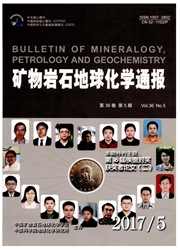

 中文摘要:
中文摘要:
双泉金矿是东准噶尔卡拉麦里金矿带中新近发现的一个中型构造蚀变岩型金矿床。矿床产于韧性剪切带中,赋矿地层为下石炭统南明水组地层,矿石类型主要为蚀变岩型。本文通过主要矿化阶段热液矿物毒砂成分的测定,利用相图中共生金属硫化物稳定温度范围得出主要矿化阶段的温度为300~450℃,它比通过石英流体包裹体测得的均一温度更准确地代表成矿流体的温度,由此温度平均值计算出的氢氢同位素能准确判断初始流体的来源。氢氢同位素的小范围内变化可能受成矿流体不同阶段温度的变化和组分变化的影响。综合地质地球化学资料表明,双泉金矿为与韧性剪切带有关的变质热液金矿床,韧性剪切带即为导矿构造和容矿构造;成矿物质可能主要来源于下石炭统南明水组中的火山岩和火山碎屑岩。
 英文摘要:
英文摘要:
Shuangquan gold deposit is a medium size tectono-alteration ore gold deposit recently discovered in kalameily gold metallogenic belt of east junggar. The deposit is hosted in ductile shear zone and occurs in Nanmingshui group formation of Lower Carboniferous. The Au ore types are mostly metamorphic rock. Based on EPMA analysis of arsenopyrite and the phase diagram of coexisting minerals pyrite-arsenopyrite, we conclud that temperature of the main mineralization stage is stable within 300~450℃. This temperature reflects the mineralization temperature much better than the homogenization temperature obtained from inclusion fluid. The isotopic compositions of oxygen and hydrogen calculated under such average temperature are more accurate when tracing the origin of ore-forming finds. The narrow variation of hydrogen and oxygen isotope could be resulted from the stage changes of temperature and composition of ore-forming fluids. Application of geological and geochemical data show that Shuangquan gold deposit is a metamorphic hydrothermal gold deposit related to ductile shear zone. Ductile shear zones provid the ore-transmitting structure and ore-depositing structures. The sources of ore-forming material may be originated from volcanic rocks and volcaniclastic rocks in Nanmingshui group formation of Lower Carboniferous.
 同期刊论文项目
同期刊论文项目
 同项目期刊论文
同项目期刊论文
 Melting of the subcontinental lithospheric mantle by the Emeishan mantle plume; evidence from the ba
Melting of the subcontinental lithospheric mantle by the Emeishan mantle plume; evidence from the ba Geochemistry of the Kalatongke Ni–Cu–(PGE) sulfide deposit, NW China: implications for the formation
Geochemistry of the Kalatongke Ni–Cu–(PGE) sulfide deposit, NW China: implications for the formation Role of crustal contamination in formation of the Jinchuan intrusion and its world-class Ni-Cu-(PGE)
Role of crustal contamination in formation of the Jinchuan intrusion and its world-class Ni-Cu-(PGE) 期刊信息
期刊信息
